
May 11, 2011
(Editor’s Note: We thought Northeast resident Brett Mach made excellent points in his letter to the editor and upgraded his status to our guest columnist of the week. Mach recently graduated from William Jewell with a degree in Humanities.)
Although I hate to bring up old news, I have just got around to reading The Pitch’s 4/24 feature on the tragic death of the Northeast’s own Yuri Ives. Accurate or not, it is a thought provoking profile that underlines many things we can learn from our late neighbor.
With all respect for Ives’s memory, it’s clear to me that most of the lessons to be learned are from his mistakes.
Our neighborhood has no shortage of eccentrics—certainly a strength when they provide positive energy and leadership, but also a liability if their energy short-circuits and altruism turns inward into self-service. And eccentricity is certainly part of who we are. It’s almost a distinctive here in what is surely the most diverse, unique (and best) neighborhood Kansas City has to offer.
But when dreams for our neighborhood get wrapped into the narrow delusions of a single individual who fills his house with antiques instead of neighbors, you can bet on another rise and fall of what could have been for our community.
The Northeast has gone through growing pains for decades and will continue to struggle with its identity for the foreseeable future. But there’s still a lot of hope to go around. I don’t presume to offer a perfect vision for what the future can be, but hopefully we can continue to make strides to figure that out as a community.
What’s for sure is that it must include all of us, which means the true grab-bag patchwork of all our different ethnicities, tax brackets, languages, personalities and occupations. This is where the real strength of the Northeast lies: in the full spectrum of our people. So full gentrification isn’t the answer. And duplicating something that exists somewhere else isn’t the answer either (be it Mass Street, Leawood, NKC, or the Crossroads).
Because Northeast people are the unique blend of folks we are, the ideal vision for what’s ahead will be like nothing that already exists elsewhere. What that looks like isn’t up to me—it’s up to us. But it certainly includes cleaning things up, controlling crime, and restoring properties in a way that the late Mr. Ives might have envisioned.
Still, physical restoration in our community will always ring hollow if not undergirded by the social capital and neighborliness of relational restoration and a refocusing on the people of our place—on all of us.
We’ve got to start by doing the hard work of getting to know one another. And this especially goes for those who are not part of our tribe—those we don’t understand—those who we secretly wish would move away (either to Johnson County or south of Truman Road, “where their types belong”), so we could have our neighborhood (and neighborhood vision) to ourselves. The technical integration in our community (and I mean integration of every sort, not merely racial), is not worth anything if we can’t swing relational integration as well.
Starting a task force or committee for intra-neighborhood dialogue is not what I’m talking about. It’s something that must start with us as people who value our neighbors. It means having people over for dinner, or for a front porch beer, with whom we don’t share much in common. That starts only with nods of hello and conversations about the weather in the checkout aisle. And it’s all incredibly difficult and unnatural—it means being uncomfortable, talking with people we disagree with, and practicing generosity (especially) when it’s undeserved or unreciprocated. And whenever we start dreaming, cynical realism is only a couple sour experiences away.
But the payoff of perseverance might be a neighborhood climate that allows dreaming to happen among all its citizens. It might help chart a course for a community model that has yet to ever be seen. We might even take some steps down the road of realizing those dreams.
It doesn’t start with someone else. It starts with us. And by us, I mean all of us that make the Northeast what it is: artists and accountants, blacks and whites, Mexicans and Argentinians, trust fund-ers and food stamp-ers, Somali Bantus and Arabs, Libertarians and Fletcher-ites, gays and straights, Karen people and Burmese people, prostitutes and churchmen, and all the other categories I’m forgetting. Hard work, to be sure. But from the burn-outs to the start-ups, at the very least we all make up an eccentric cocktail of potential.
I hope leaders will emerge in our community who can catalyze a vision for the Northeast created by and for all of us. To do that, I propose reworking The Pitch’s concluding Yuri Ives quote as related through Ron McGee: “We can make this a great place again, I know it. All we need are people who believe in the past.”
The Northeast can certainly become great again. But let’s not content ourselves with nostalgia for what maybe never was. Anyway, all of us have changed since then (and for the better). All we really need are people who believe in the future.















